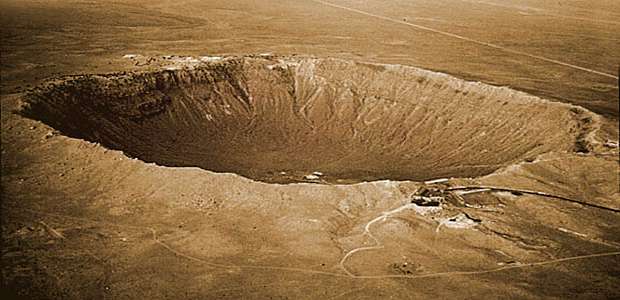Thousands of years ago a cosmic missile hurtled to Earth, blasting a colossal crater in the arid landscape of the Arizona Desert. Some 30,000 to 50,000 years ago, many centuries before human beings arrived in North America, a giant chunk of rock struck the Earth near Canyon Diablo, between the towns of Flagstaff and Winslow in Arizona. It gouged out a huge saucer-shaped depression 4100ft (1250m) across and 570ft (174m) deep.
Viewed from the flat surrounding desert, the 150ft (45m) high rim of the crater appears as no more than a low ridge, and consequently the yawning hole it conceals was not reported by Europeans until 1871. Initially it was thought to be volcanic like similar craters, such as Sunset Crater nearby, which had already been explored. In 1890, iron fragments were discovered in the debris; although their significance was not immediately recognized, some scientists began to question the volcanic explanation and to lean towards the theory than this great scar must have been caused by an extraterrestrial body hitting the Earth.
After examining the site in 1902, Dr Daniel Barringer, a mining engineer from Philadelphia, became so convinced that a huge iron-rich meteorite lay beneath the crater floor that he bought the land and in 1906 started to drill. At first he believed that, because the crater was roughly circular in shape, the body that had created it must lie under the centre. Later he discovered that a rifle bullet fired into soft mud, even from a low angle, would always make a round hole.
This fact, coupled with the knowledge that the rock strata on the south-eastern side of the crater were more than 100ft (30m) above the levels elsewhere, led him to conclude that the meteorite had come in from the north at a lw angle and buried itself beneath the south-eastern rim. Drilling was started at this site. At 1000ft (305m) an increasing number of iron and nickel-iron fragments was found; at 1376ft (420m) the drill became completely jammed – wedged, it seemed, in hard meteoric material. Money ran out and drilling stopped in 1929, but by now the scientific world was persuaded that the crater had indeed been caused by the impact of a meteorite.
The weight and size of the missile that hammered into the Arizona Desert has been a subject of speculation. In the 1930s, scientists estimated its weight at 14 million tons and its diameter at 400ft (122m). Later calculations scaled down the size of the meteorite to 2 million tons, with a diameter of 260ft (79m); current estimates suggest a weight of some 70,000 tons and a diameter of 80-100ft (25-30m). Even if the size of the cosmic invader were no larger than the smallest estimate to date, its collision with our planet was nevertheless cataclysmic.
To make such a massive crater, It must have plunged through the atmosphere at a speed of around 43,000mph (69,000km/h). The earth-shattering impact generated a blast equivalent to 500,000 tons of high explosive (some 40 times greater than the force of the atomic bomb that obliterated the Japanese city of Hiroshima), throwing 100 million tons of pulverized rock into the atmosphere. It also banked up the material that now forms the crater’s rim.

Drops of molten metal from the meteorite showered down over an area of 100 sq. miles (260km), some pieces landing as far as 7 miles (11km) from the point of impact. Many of these fragments were only the size of pebbles; the largest weighed as much as 1400lb (630kg). Both the rubble at the crater’s rim and the material thrown outwards consisted of a mixture of sandstone and limestone – the remains of fossil-rich deposits from the prehistoric lake that had once flooded the region. A thick, lens-shaped layer of this same crushed mixture, called breccia, now covers the crater floor.
During the 1930s, considerable sums of money were spent on drilling bores through the breccia into the crater floor in attempts to locate deposits of iron that could be profitable mined. Traces of nickel-iron were found at depths up to 853ft (260m); below this level the rock was undisturbed. Modern methods involving seismic, magnetic and gravitational surveying suggest that what remains of the meteorite does lie below the south rim, but that this is more than ten per cent of the original mass. Most of the rest vaporized on impact condensing to form nickel-iron fragments.
In 1960, traces of two rare forms of silica – coesite and stishovite – were discovered in the bowl, both of which can be generated artificially under extreme pressure and temperature. (Although stishovite can form under pressure deep within the Earth, it changes back into quartz before it reaches the surface). Their natural presence on the site thus provided indisputable evidence of a colossal impact. Any doubts that might have existed about the crater’s formation were erased, and Barringer’s belief in the meteorite origin of the crater that now bears his name was vindicated.

Our Earth has been quite lucky and has been fortunate enough to escape one large meteor escaping its orbit earlier this year. However, the Chelyabinsk meteor crash in Russia which also took place around the same time is surely a wake-up call for the researchers that more meteors are headed our way.



































